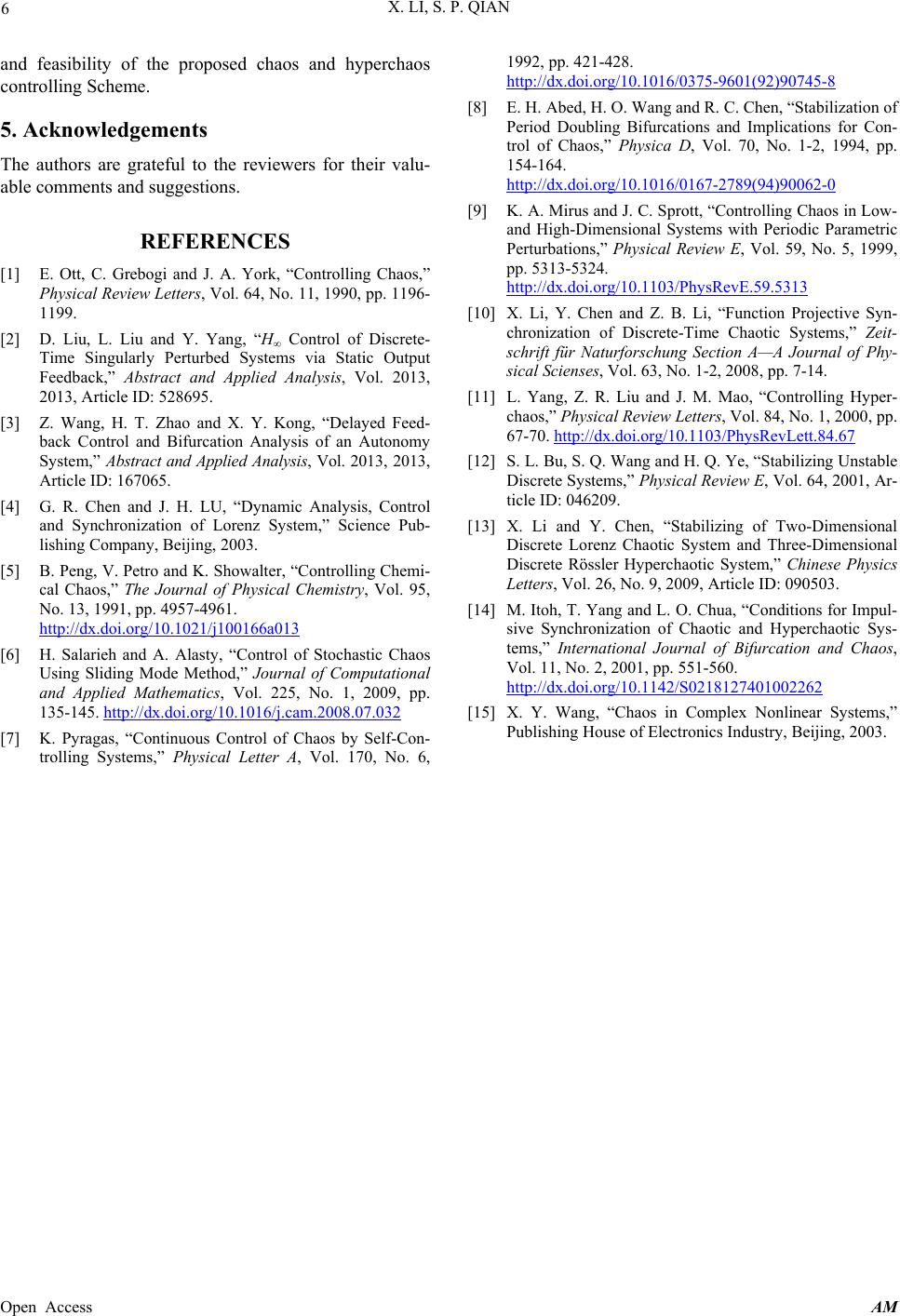
X. LI, S. P. QIAN
6
and feasibility of the proposed chaos and hyperchaos
controlling Scheme.
5. Acknowledgements
The authors are grateful to the reviewers for their valu-
able comments and suggestions.
REFERENCES
[1] E. Ott, C. Grebogi and J. A. York, “Controlling Chaos,”
Physical Review Letters, Vol. 64, No. 11, 1990, pp. 1196-
1199.
[2] D. Liu, L. Liu and Y. Yang, “H∞ Control of Discrete-
Time Singularly Perturbed Systems via Static Output
Feedback,” Abstract and Applied Analysis, Vol. 2013,
2013, Article ID: 528695.
[3] Z. Wang, H. T. Zhao and X. Y. Kong, “Delayed Feed-
back Control and Bifurcation Analysis of an Autonomy
System,” Abstract and Applied Analysis, Vol. 2013, 2013,
Article ID: 167065.
[4] G. R. Chen and J. H. LU, “Dynamic Analysis, Control
and Synchronization of Lorenz System,” Science Pub-
lishing Company, Beijing, 2003.
[5] B. Peng, V. Petro and K. Showalter, “Controlling Chemi-
cal Chaos,” The Journal of Physical Chemistry, Vol. 95,
No. 13, 1991, pp. 4957-4961.
http://dx.doi.org/10.1021/j100166a013
[6] H. Salarieh and A. Alasty, “Control of Stochastic Chaos
Using Sliding Mode Method,” Journal of Computational
and Applied Mathematics, Vol. 225, No. 1, 2009, pp.
135-145. http://dx.doi.org/10.1016/j.cam.2008.07.032
[7] K. Pyragas, “Continuous Control of Chaos by Self-Con-
trolling Systems,” Physical Letter A, Vol. 170, No. 6,
1992, pp. 421-428.
http://dx.doi.org/10.1016/0375-9601(92)90745-8
[8] E. H. Abed, H. O. Wang and R. C. Chen, “Stabilization of
Period Doubling Bifurcations and Implications for Con-
trol of Chaos,” Physica D, Vol. 70, No. 1-2, 1994, pp.
154-164.
http://dx.doi.org/10.1016/0167-2789(94)90062-0
[9] K. A. Mirus and J. C. Sprott, “Controlling Chaos in Low-
and High-Dimensional Systems with Periodic Parametric
Perturbations,” Physical Review E, Vol. 59, No. 5, 1999,
pp. 5313-5324.
http://dx.doi.org/10.1103/PhysRevE.59.5313
[10] X. Li, Y. Chen and Z. B. Li, “Function Projective Syn-
chronization of Discrete-Time Chaotic Systems,” Zeit-
schrift für Naturforschung Section A—A Journal of Phy-
sical Scienses, Vol. 63, No. 1-2, 2008, pp. 7-14.
[11] L. Yang, Z. R. Liu and J. M. Mao, “Controlling Hyper-
chaos,” Physical Review Letters, Vol. 84, No. 1, 2000, pp.
67-70. http://dx.doi.org/10.1103/PhysRevLett.84.67
[12] S. L. Bu, S. Q. Wang and H. Q. Ye, “Stabilizing Unstable
Discrete Systems,” Physical Review E, Vol. 64, 2001, Ar-
ticle ID: 046209.
[13] X. Li and Y. Chen, “Stabilizing of Two-Dimensional
Discrete Lorenz Chaotic System and Three-Dimensional
Discrete Rössler Hyperchaotic System,” Chinese Physics
Letters, Vol. 26, No. 9, 2009, Article ID: 090503.
[14] M. Itoh, T. Yang and L. O. Chua, “Conditions for Impul-
sive Synchronization of Chaotic and Hyperchaotic Sys-
tems,” International Journal of Bifurcation and Chaos,
Vol. 11, No. 2, 2001, pp. 551-560.
http://dx.doi.org/10.1142/S0218127401002262
[15] X. Y. Wang, “Chaos in Complex Nonlinear Systems,”
Publishing House of Electronics Industry, Beijing, 2003.
Open Access AM